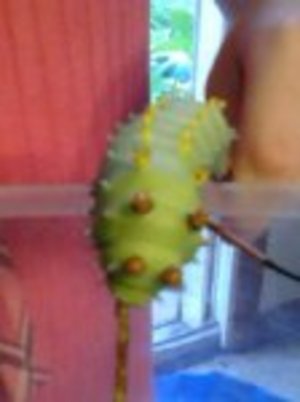Have you ever found a caterpillar and wondered what it was going to turn into? Our daughter found a large green caterpillar in her favorite tree for climbing. With a little effort, we were able to identify our large green caterpillar and learn about the Cecropia Silkmoth it will hopefully develop into.
Our daughter came into the house asking for either my husband or I to go see something. I chose to go see what she had found this time. She said there was a green pointy-looking thin up in the tree. I finally saw what she was referring to and it was a large green caterpillar. Let me rephrase, it was a huge green caterpillar at 4 ½ inches long.
Although we get huge moths in our area, I had never seen such a large green caterpillar in my life. After carefully obtaining the specimen, my husband brought it into the house so I could get a picture. Our daughter put it into a temporary plastic container with a couple of small, leaf-covered branches.
After taking a few pictures of the large green caterpillar, I set to work on identifying this strange creature. After typing in “large caterpillar” on my search bar, I was assaulted with internet listings, some of which only discussed specific caterpillars.
Using separate tabs, I pulled up the information on sites that offered identification of a variety of caterpillars. Discover Life – Caterpillar Identification Guide & Checklist1 gave us some options to identify the large green caterpillar, which our daughter had already named “Bob”.
How We Identified Our Large Green Caterpillar Using Discover Life
Discover Life gives four options to identify a caterpillar. You can choose by main body color, main body pattern, hair pattern or distinct features. There are several subcategories with pictures under the main categories listed. We already knew we had a large green caterpillar, so choosing that option with 69 varieties wasn’t our first option.
Luckily, the large green caterpillar we were identifying had some distinct features – knobs. As it turned out, not only were only 22 varieties to select from with knobs, the specimen we were searching happened to be the one pictured under the main example for “knobs”.
We found out our large green caterpillar is called Hyalophora cecropia. With further searching, we found the common name is the Cecropia Silkmoth. There is a good picture of the Cecropia Silkmoth on the website Butterflies and Moths of North America2 maintained by the Big Sky Institute at Montana State University. You can see a beautiful picture there of the moth that our large green caterpillar will turn into. There is also a map with documented records of habitat.
Once I saw a picture of Cecropia Silkmoth, I realized I should have known the large green caterpillar, I mean “Bob”, was the larva of this moth. Although these moths are usually only seen at night, they are attracted to light and we have seen several in our area over the years.
The Cecropia Silkmoth larva molts four times. Bob was in his final stage of being a larva before he will make a cocoon for winter and emerge in spring as one of the largest moths in our area.
1) John Pickering; Discover Life – Caterpillar Identification Guide & Checklist; University of Georgia
2) Big Sky Institute, Montana State University; Butterflies and Moths of North America; Butterflies and Moths of North America




